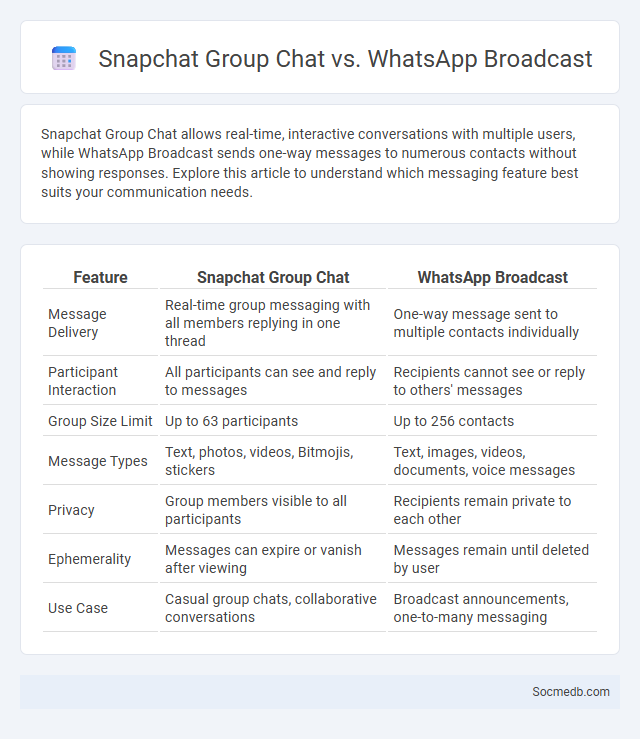
Photo illustration: Snapchat Group Chat vs WhatsApp Broadcast
Snapchat Group Chat allows real-time, interactive conversations with multiple users, while WhatsApp Broadcast sends one-way messages to numerous contacts without showing responses. Explore this article to understand which messaging feature best suits your communication needs.
Table of Comparison
| Feature | Snapchat Group Chat | WhatsApp Broadcast |
|---|---|---|
| Message Delivery | Real-time group messaging with all members replying in one thread | One-way message sent to multiple contacts individually |
| Participant Interaction | All participants can see and reply to messages | Recipients cannot see or reply to others' messages |
| Group Size Limit | Up to 63 participants | Up to 256 contacts |
| Message Types | Text, photos, videos, Bitmojis, stickers | Text, images, videos, documents, voice messages |
| Privacy | Group members visible to all participants | Recipients remain private to each other |
| Ephemerality | Messages can expire or vanish after viewing | Messages remain until deleted by user |
| Use Case | Casual group chats, collaborative conversations | Broadcast announcements, one-to-many messaging |
Overview of Snapchat Group Chat, WhatsApp Broadcast, and WhatsApp Group Chat
Snapchat Group Chat enables real-time multimedia messaging with ephemeral snaps and stories, fostering dynamic interactions among friends. WhatsApp Broadcast sends one-way messages to multiple contacts simultaneously without revealing recipients, ideal for announcements and updates. WhatsApp Group Chat supports two-way communication among members, allowing you to share texts, images, videos, and voice notes within a closed community for collaborative conversations.
Key Features Comparison: Snapchat vs WhatsApp
Snapchat excels in ephemeral messaging, augmented reality filters, and content discovery through Stories and Spotlight, targeting a younger demographic. WhatsApp offers robust end-to-end encryption, seamless text, voice, and video calls, and group chat functionalities with over 2 billion active users globally. Both platforms support multimedia sharing but differ significantly in privacy controls and user engagement styles.
Privacy and Security: Which Platform Offers Better Protection?
When comparing social media platforms, privacy and security measures vary significantly, with some prioritizing end-to-end encryption and robust data protection policies, while others may expose users to greater risks through less stringent controls. Platforms like Signal and Telegram offer enhanced privacy features, including encrypted messaging and minimal data retention, whereas Facebook and Instagram have faced scrutiny over data breaches and user information sharing. To safeguard Your personal information, it is crucial to choose a platform with transparent privacy policies and rigorous security protocols.
Message Delivery and Notification Differences
Message delivery on social media varies depending on platform algorithms, with some prioritizing direct messages for faster user response while others use feed posts that may delay visibility. Notifications differ, where platforms like Facebook provide real-time alerts for comments and reactions, whereas Twitter focuses on mention and retweet notifications to enhance engagement. Tailoring your settings ensures your messages reach the intended audience promptly, optimizing interaction and response rates.
Media Sharing Capabilities: Photos, Videos, and Files
Social media platforms offer advanced media sharing capabilities that allow you to upload and share photos, videos, and files seamlessly across your network. High-resolution photo sharing and HD video uploads enhance visual storytelling, while integrated file-sharing options support collaboration and content distribution. Optimized media formats and quick loading times ensure your shared content reaches your audience efficiently and effectively.
User Control and Administrative Tools
User control on social media platforms empowers you to customize privacy settings, manage content visibility, and control interactions with others. Administrative tools enable efficient moderation by flagging inappropriate behavior, setting content filters, and enforcing community guidelines. These features collectively enhance user safety and curate a personalized online experience.
Customization Options for Groups and Broadcasts
Social media platforms offer extensive customization options for groups and broadcasts, enabling users to tailor content visibility, engagement settings, and member roles for enhanced interaction. Features such as customizable privacy levels, post approval processes, and targeted broadcast segments optimize communication and audience management. These tools empower creators and administrators to foster focused communities and deliver relevant, personalized content effectively.
Engagement and Interaction Features
Social media platforms offer a variety of engagement and interaction features such as likes, comments, shares, and live streaming that enhance user participation and real-time communication. These tools enable Your content to reach broader audiences, fostering community growth and meaningful connections. Effective use of these features boosts visibility, encourages dialogue, and strengthens relationships with followers.
Platform Limitations and User Capacity
Social media platforms often face limitations in user capacity due to server infrastructure and bandwidth constraints, impacting real-time interaction and content delivery. Scalability challenges affect platform performance during peak usage, leading to slower load times and potential outages. Efficient resource allocation and technological upgrades are critical to maintaining optimal user experience and accommodating growing user bases.
Which Group Messaging Platform Is Best for You?
When choosing the best group messaging platform for you, consider factors such as user interface, security features, and integration capabilities with other apps. Popular platforms like WhatsApp, Slack, and Microsoft Teams offer varied benefits including end-to-end encryption, customizable notifications, and collaboration tools tailored for personal or professional use. Assessing your specific needs for privacy, message volume, and multimedia sharing will help determine which platform aligns perfectly with your communication style.
 socmedb.com
socmedb.com